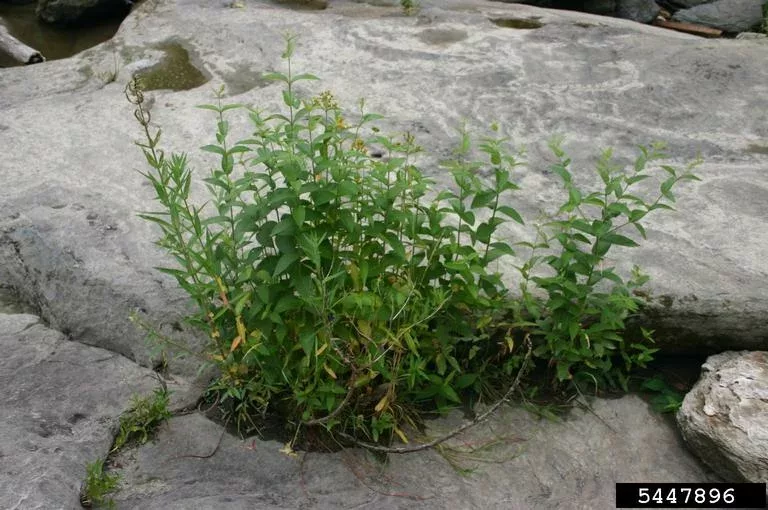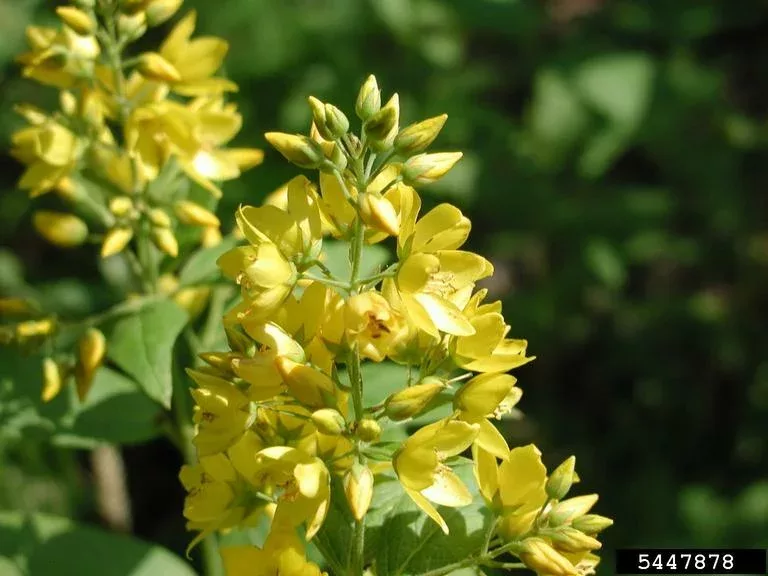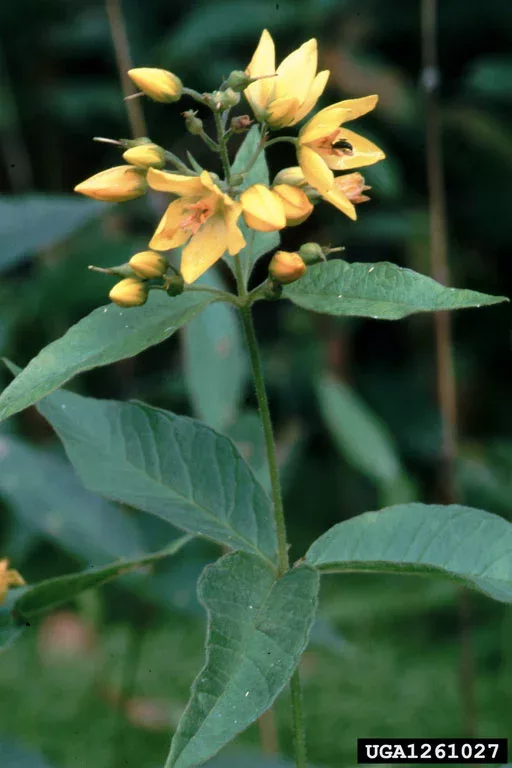
Appearance
Lysimachia vulgaris is an herbaceous perennial with erect stems up to 3.3 ft. (1 m) in height and long, stolon-like rhizomes that can run 33 ft. (10 m) long.
Foliage
The leaves of this plant are opposite or whorled. They have small glands that are black or orange in color and soft hairs beneath. They are lanceolate to laceolate-ovate in shape, 2.75-4.75 in. (7-12 cm) in length and 0.6-1.5 in. (1.5-4 cm) in width. The middle and upper leaves have short petioles and are acuminate.

Flowers
The inflorescence is a terminal, leafy panicle that appears June-September. The flowers are have five yellow petals and are 0.5-0.75 in. (1.2-2 cm) across. The lobes of the calyx are red-margined and 0.15-0.2 in. (3.5-5 mm) long.

Fruit
The fruits are dry capsules. The seeds of this plant are most likely water-dispersed. However, the main method of dispersal for this plant is via rhizomes.

Lysimachia vulgaris presents a similar threat as the serious invasive Lythrum salicaria (purple loosestrife). In Washington state it has been reported as possibly outcompeting Lythrum salicaria in wetland habitats. The rhizomes spread readily. Though its populations have not yet reached the numbers of Lythrum salicaria populations, it has the potential to do so. Lysimachia vulgaris prefers moist soil, and will invade fens, wet woods, lake shores, rocky river shores and riparian zones.
Yellow loosestrife has displaced native vegetation in wetlands and along streambanks and reduced habitat for waterfowl and fish (King County 2010). Yellow loosestrife has also been observed outcompeting purple loosestrife (Lythrum salicaria); a very problematic weed that is also found in the Great Lakes (State of Washington 2013).
Bossuyt et al. (2005) observed that plant populations dominated by Lysimachia vulgaris had decreased total species richness compared to populations nominated by other invasive plant species. It was also observed that when there was a majority of L. vulgaris present, palatable plant species produced significantly more inflorescences (Bossuyt et al. 2005).
This species can also create dense communities which alter the local hydrology by clogging shallow waterways and increasing sedimentation (King County 2010).
It may occupy the same niche as Lysimachia radicans, which is endangered in Indiana (Indiana Natural Heritage Database 2011).
Lysimachia vulgaris is an unpatalable species that is avoided by large herbivores due to toxic compounds (Bossuyt et al. 2005).
Lysimachia spp. are susceptible to rust and leaf spots (Missouri Botanical Garden 2012).

The New York Invasive Species Council determined that this species poses a high ecological threat and recommends that it be prohibited within the state (New York Invasive 2010).
The Great Lakes Indian Fish and Wildlife Commission considers this species capable of causing severe ecological impacts and recommends it be controlled within their ceded territories (Falck and Garske 2003).
Note: Check federal, state/provincial, and local regulations for the most up-to-date information.
Control
Biological
There are no known biological control agents for this species (King County 2010).
Physical
Hand-pulling is effective for small infestations and/or for young plants (King County 2010, MISIN and MNFI 2013). Care should be taken to dig out and remove all plant fragments, especially the rhizomes, to prevent regrowth (King County 2010). All seed heads and rhizomes pieces should be disposed of in plastic bags and removed from the site (King County 2010).
Repeated mowing of L. vulgaris may contain the existing population, but it will not eradicate it (King County 2010).
Chemical
To control larger infestations, treatment with herbicides containing glyphosate, imazapyr, or triclopyr may be necessary (King County 2010). It is important to note that glyphosate and imazapyr are non-selective and will harm any plant it comes in contact with (King County 2010).Tricolpyr will not harm grasses, sedges, or cattails, and may be more appropriate to use in diverse plant communities (King County 2010).
Physical control methods should not be used on populations treated with herbicides until several weeks after application (King County 2010).
Note: Check state/provincial and local regulations for the most up-to-date information regarding permits for control methods. Follow all label instructions.
